Nial Moores, February 2, 2015
 Immature Temminck’s Cormorant, Goseong County, Gangwon, January 2013 © Nial Moores
Immature Temminck’s Cormorant, Goseong County, Gangwon, January 2013 © Nial Moores
The 2014 Birds Korea Checklist includes three cormorant species: Pelagic Cormorant Phalacrocorax pelagicus, Great Cormorant Phalacrocorax carbo and Temminck’s Cormorant Phalacrocorax capillatus (the latter being a much better name than “Japanese Cormorant” for a species that is now known to breed in coastal Korea, part of Russia and probably parts of China in addition to Japan, especially too when the hanedae subspecies of Great Cormorant is believed largely confined to Japan).
Pelagic Cormorant is easy to identify, being much smaller-headed and thinner-billed than both Great and Temminck’s, and confusion with the extra-limital Red-faced Cormorant (a more northerly-distributed species unlikely ever to occur in Korean waters) seems much less likely following massive improvements in the quality of domestic field-guides (e.g. Park Jong-Gil’s 2014 Wild Birds Field-guide).
Separation of Temminck’s and Great is rather more challenging. Major field ID features of Temminck’s from Great Cormorants were first outlined in detail by Lethaby and Moores in Dutch Birding in 1999, based on their experiences of both species in Japan. These included habitat choice (as in Japan Temminck’s is more a species of marine habitats, and Great is rather more typical of rivers, lakes and estuaries, though also occurring in more marine-type areas); bare part coloration in the non-breeding season (most especially the lower mandible which is yellow and more or less concolorous with the lores in Temminck’s and which is pinky-grey or grey-blue in Great in non-breeding birds, becoming darker in both species during the breeding season); extent of white on the head and underparts (at different ages and especially in non-breeding plumage, with Temminck’s generally showing more white); details of the scapulars (often pale-marked in immature and non-breeding Temminck’s, plain in Great); gloss on the wing-coverts of breeding-plumaged birds (greener in Temminck’s, and usually more bronzed in Great); and perhaps most importantly, details of the bare skin. In short, Temminck’s shows more bare skin around and behind the eye than Great; and its gape line comes to a sharp point at the rear, forming a tight angle both above and below the gape line. The rear edge of the bare skin is more rounded in Great, especially below the gape line.
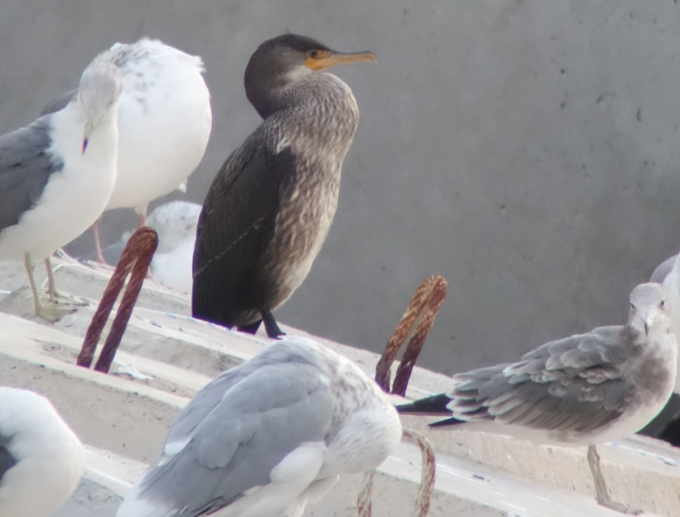 Immature (First Calendar-year?) Temminck’s Comorant, Ulleung Island, November 2014 © Nial Moores
Immature (First Calendar-year?) Temminck’s Comorant, Ulleung Island, November 2014 © Nial Moores
 Second Calendar-year Temminck’s Cormorant, Gageo Island, February 2010 © Nial Moores
Second Calendar-year Temminck’s Cormorant, Gageo Island, February 2010 © Nial Moores
 Presumed Third Calendar-year Temminck’s Cormorant (front) with Pelagic Cormorants, January 2009, Goseong County © Nial Moores
Presumed Third Calendar-year Temminck’s Cormorant (front) with Pelagic Cormorants, January 2009, Goseong County © Nial Moores
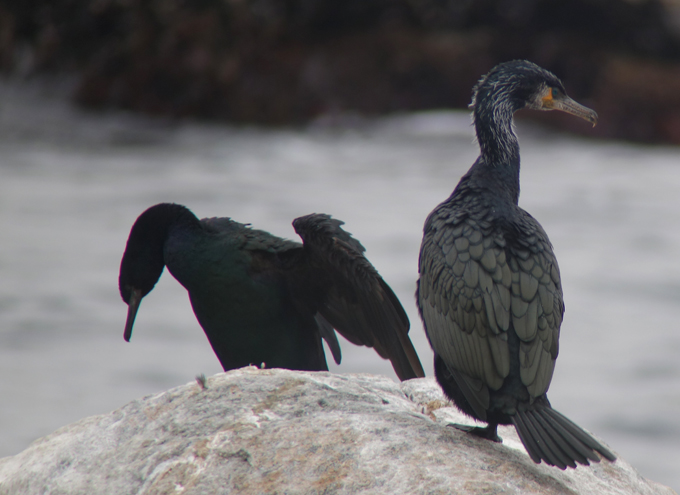 Incipient Breeding-plumaged Temminck’s Cormorant, Goseong County, January 2015 (right), with Pelagic Cormorant
Incipient Breeding-plumaged Temminck’s Cormorant, Goseong County, January 2015 (right), with Pelagic Cormorant
© Nial Moores
 Breeding-plumaged Temminck’s Cormorant, Socheong Island, April 2009 © Nial Moores
Breeding-plumaged Temminck’s Cormorant, Socheong Island, April 2009 © Nial Moores
In the Korean context, the widespread and common Great Cormorant of inland freshwater habitats is sinensis. Some immature birds show extensive pale on the underparts; many individuals look quite small-billed; and the bare skin below the gape line is obviously rounded, making separation from Temminck’s quite straightforward.
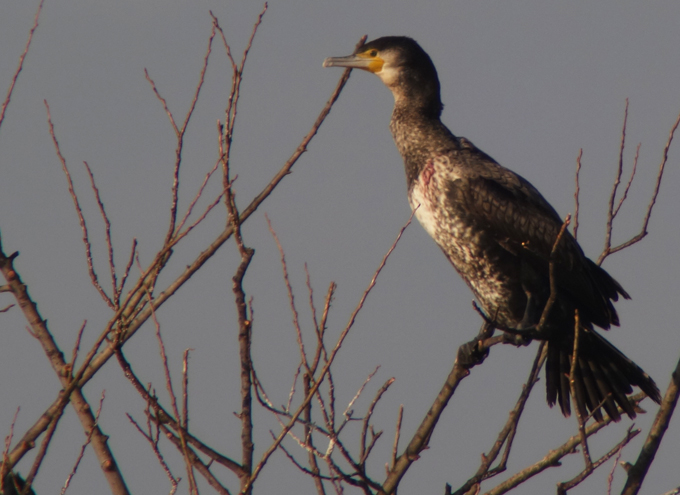 Immature (Second Calendar-year?) Great Cormorant, subspecies sinensis, Junam, January 2015 © Nial Moores
Immature (Second Calendar-year?) Great Cormorant, subspecies sinensis, Junam, January 2015 © Nial Moores
 Non-breeding adult-type Great Cormorant, subspecies sinensis (?), Junam, January 2015 © Nial Moores
Non-breeding adult-type Great Cormorant, subspecies sinensis (?), Junam, January 2015 © Nial Moores
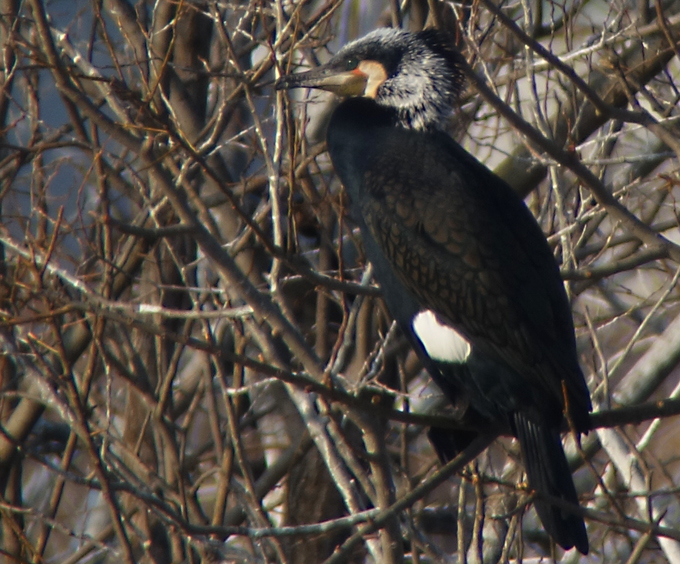 Breeding-plumaged adult Great Cormorant, subspecies sinensis, Junam, January 2015 © Nial Moores
Breeding-plumaged adult Great Cormorant, subspecies sinensis, Junam, January 2015 © Nial Moores
Separation of (the often disputed) hanedae and (the widely-accepted) sinensis subspecies of Great Cormorant appears to have received much less attention. Lethaby and Moores (1999) was focused primarily on separation of Great from Temminck’s, and only touched on one main feature considered potentially useful in separating hanedae from sinensis: the much less extensive white on the underparts of juvenile and immature hanedae compared to some sinensis. One figure also suggested that the base of the bill in breeding hanedae might be more obviously contrasting than in some sinensis.
The Birds Korea Checklist (2014) concurs with other leading checklists in presuming that sinensis is the regularly-occurring subspecies of Great in the Republic of Korea. We therefore list sinensis as a proven breeder and winter visitor, while hanedae is listed as Data Deficient, being included on the basis of possible subtle differences in facial pattern shown by some birds (most especially white extending along the underside of the bill) combined with habitat niche, namely use of marine habitat for feeding and roosting. Such birds have been seen several times on Jeju, perhaps once on Socheong Island in the West Sea, at least once in Goseong County in Gangwon Province, and at least once on Ulleung Island. Are these indeed hanedae, if hanedae proves to be a “good” taxon?
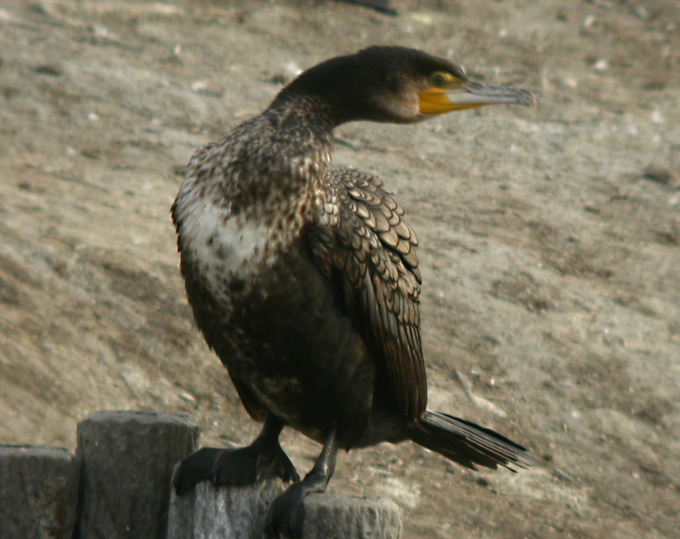 Immature Great Cormorant, subspecies hanedae, Tokyo, February 2005 © Nial Moores
Immature Great Cormorant, subspecies hanedae, Tokyo, February 2005 © Nial Moores
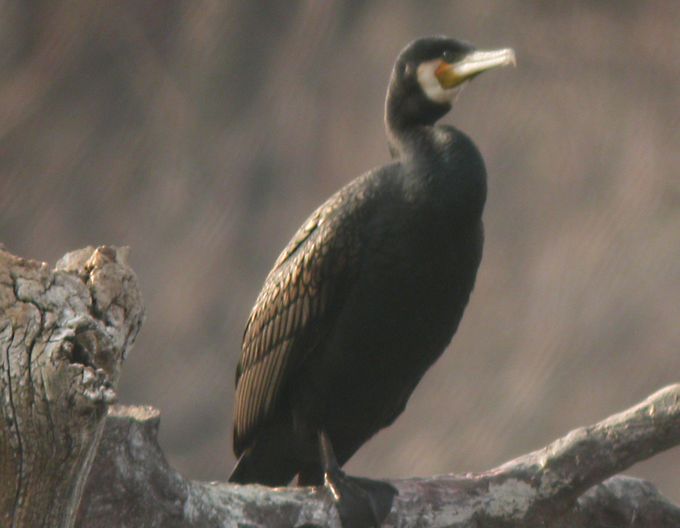 Non-breeding adult-type Great Cormorant, subspecies hanedae, Tokyo, February 2005 © Nial Moores
Non-breeding adult-type Great Cormorant, subspecies hanedae, Tokyo, February 2005 © Nial Moores
 Breeding-plumaged adult Great Cormorant, subspecies hanedae, showing white extending under the bill, Tokyo, February 2005 © Nial Moores
Breeding-plumaged adult Great Cormorant, subspecies hanedae, showing white extending under the bill, Tokyo, February 2005 © Nial Moores
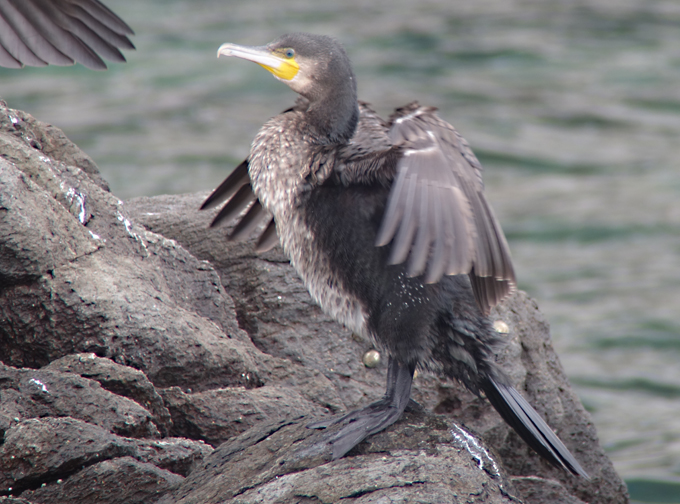 Immature Great Cormorant, perhaps of subspecies hanedae (?), Ulleung Island, November 2014 © Nial Moores
Immature Great Cormorant, perhaps of subspecies hanedae (?), Ulleung Island, November 2014 © Nial Moores
It would be very helpful to receive or see images from other parts of East Asia and Eurasia, to help improve both national and regional understanding of identification criteria and to establish distribution, abundance and population trends more clearly. Subspecies sinensis is common and widespread in large parts of East Asia and is locally common and increasing in Korea, now breeding at several sites. It is also migratory. All the same, (surpisingly) only the hanedae subspecies of Great Cormorant is listed for Japan according to the Seventh Revised Edition of the Check-List of Japanese Birds, published by the Japanese Ornithological Society (2012): is sinensis being overlooked there? Or is “Race hanedae… better considered synonymous with sinensis” as suggested by Orta et al. (2014)?
If hanedae proves to be a “good” taxon, then field identification of sinensis and hanedae seems especially worthwhile. This is because:
- In western Europe, nominate Great Cormorant is traditionally found largely in coastal habitats and often nests on cliffs; whereas sinensis (the “Continental Cormorant”), is traditionally found more often in inland freshwater wetlands and nests in trees, reed-beds and on the ground;
- Sinensis occurs naturally right the way across parts of Europe and Asia, so that carbo and hanedae are separated by a huge landmass, each occupying different ocean basins, with some hanedae at least also found in marine habitats (raising the possibility of species-level divergence);
- Apparently thanks in part to the increase of artificial wetlands stocked with fish, Great Cormorant (especially sinensis) has undergone a dramatic increase in recent decades both in Western Europe and perhaps also in parts of Eastern Asia. Great Cormorant, whether all hanedae or not, have also shown a large increase in parts of Japan since the 1970s. Either way, the species increasingly comes into conflict with “fish-farmers.” Some birds have also been killed by Poultry Flu. If appropriate management strategies are to be developed, it is best if they are based on a solid understanding of the ecological requirements and population trends at the population and subspecies level, rather than only at the species level.
- A paper by Marion and Le Gentil (2006) has recently received a fair amount of interest in Europe, including on the pioneering Birding Frontiers website. This is because it identifies an additional clade of Great Cormorant found in northern Europe which the authors called “norvegicus”. The authors state that subspecies “norvegicus” is part of Great Cormorant but it shows some genetic closeness to Temminck’s Cormorant (though see this discussion here). Some low resolution images of Great Cormorant photographed in Norway on the Birding Frontiers website suggest an obvious white jowl and extension of white under the bill (apparently often shown by hanedae, but perhaps lacking or unusual in sinensis): could “norvegicus” be a missing link between nominate carbo and hanedae?
With thanks to Richard Klim for his comments (on February 2nd) posted to the Kantori List-server, and in the understanding that further informed comments, images, opinions and questions are always most welcome!
